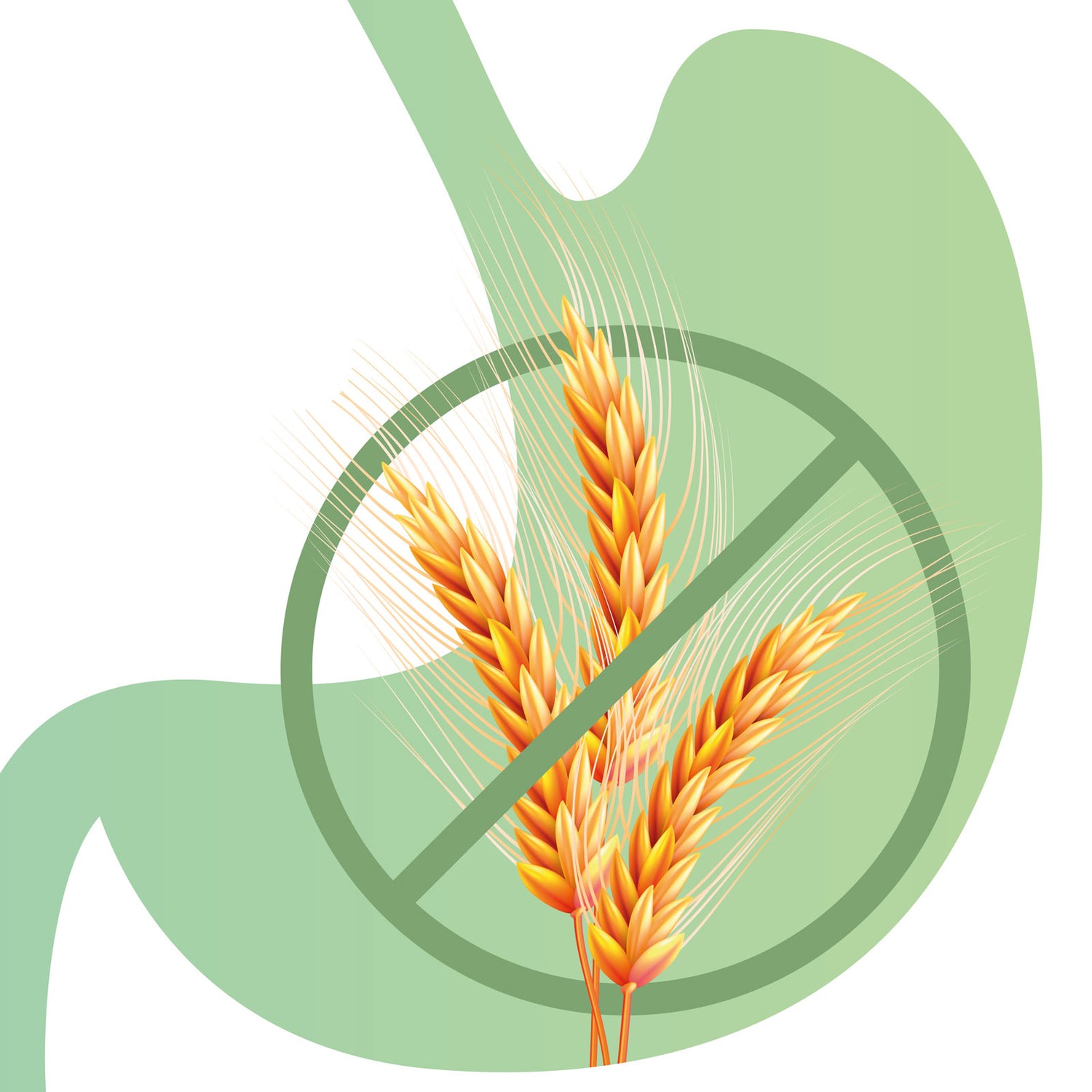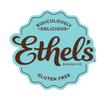If you have Celiac Disease, gluten intolerance or want to reduce gluten in your diet, you can enjoy Ethel's dessert bars, cookies and brownies without worry. All of our baked goods are certified gluten-free and carry the gluten-free seal from The Gluten-Free Certification Organization (GFCO), a program of the Gluten Intolerance Group (GIG).

What is Celiac Disease?
Though celiac disease is becoming more well known and more prevalent, most people don’t deeply understand what it is, where it comes from, or how it’s treated. Unless you or a loved one has been diagnosed, you may reduce it to an aversion to bread or a distaste for wheat-based baked goods. But in reality the severity of the disease is not something to take lightly.
Celiac is an autoimmune disease that attacks the digestive system. When gluten—a protein found in many grains, including barley, wheat, and rye—enters the bodies of people with the disease, that protein triggers an immune response. The primary target of attack is the villi that line the walls of the small intestine. These bodies—which are responsible for the absorption of nutrients from food—are damaged with repeated injury, which can result in several poor health outcomes, including malnutrition.
When undiagnosed and untreated, celiac disease can lead to severe health conditions, as repeated gluten exposure can eventually destroy the villi and result in a non functioning small intestine. Additionally, other autoimmune diseases and health conditions can develop.
What is Gluten Insensitivity?
Some people who aren’t celiac—that is, they don’t have an autoimmune disease or a genetic abnormality—react with celiac-like symptoms when they eat gluten. This condition is referred to as non-celiac gluten sensitivity or NCGS. Technically, people with NCGS don’t have an allergy to gluten since their immune systems are not responding to gluten when it enters the body. Rather, some research suggests that the symptoms of NCGS are caused by the body’s failure to break down a certain carbohydrate found in several foods. While other research indicates that wheat irritates the lining of people with NCGS. Though the causes are not definitive, the solution is. To avoid symptoms, people who are gluten intolerant need to avoid gluten.
What Causes Celiac Disease?
Research indicates that most celiac disease is found in people with a genetic predisposition for the condition. Specifically, there are two genes known to be associated with the disease, and most celiacs have one or both of them. Approximately 95% of celiacs have one of them, and the other 5% have the other gene.
Genetic testing for the presence of these genes is available. And we should note that if you have one of the two genes you are at risk for celiac disease, it does not necessarily mean that you have the disease.
If you have a parent, sibling, or child who has the disease, you are more likely to have it. And, if you have the disease, about 5-10% of your blood relatives are likely to have it. People who have a different autoimmune disease—for example type 1 diabetes and thyroid disease—are also at risk for celiac disease.
Common Symptoms Of Celiac Disease
The presentation of celiac disease takes on many forms. In fact, the disease can trigger over 200 symptoms. And because the appearance of the disease varies widely, it can be hard to diagnose. In fact, about 80% of celiacs are misdiagnosed or undiagnosed.
While some people with celiac disease begin showing symptoms as soon as they start eating gluten— in early childhood—some people with the disease don’t show symptoms until they are adults. The digestive system is usually most impacted by the symptoms of celiac disease, but they can appear in other parts of the body as well.
A few of the most common symptoms in children include:
- Fatigue
- Pain in and bloating of the abdomen
- Constipation
- Vomiting and nausea
- Irritability
- Abnormal stool
- Gas
- Weight loss
- Headaches
- ADHD or other learning disabilities
- Frequent diarrhea
- Puberty delay
- Failure to hit growth metrics
- Anemia
- Depression and anxiety
- Fatigue
Common symptoms in adults include:
- Weight loss
- Joint paid
- Mouth ulcers
- Irregular periods
- Gas and bloating
- Anxiety and depression
- Skin rashes
- Vomiting and nausea
- Anemia
- Constipation
- Impair cognition
- Diarrhea
- Migraines or headaches
If you are the first degree relative of someone with celiac (child, parent, sibling), you have a 1 and 10 chance of contracting the disease. Even if you have no symptoms, you should be screened for the disease so that you can adjust your diet if necessary and avoid long-term health consequences.
Who Should Get Tested? How Do They Test?
Because celiac is a hereditary disease that can lead to other autoimmune diseases, the Celiac Disease Foundation recommends that anyone with a sibling, parent, or child who has the disease get tested. Additionally, they recommend that anyone over the age of three who is demonstrating symptoms of the disease should be screened.
There are a variety of blood tests that screen for celiac disease. For the results to be accurate, the person being screened has to have gluten in their diet so that the test can register the presence of the antibodies that respond in a celiac when gluten is in the body.
Though blood tests can accurately test for the body’s response to the presence of gluten, the most definitive way to diagnose celiac disease is with a biopsy of the small intestine. Some people who are not celiac have gluten sensitivity that could alter the results of a blood test. A biopsy will reveal inflammation or damage, which is a more conclusive result.
Because the endoscopy is so invasive, many doctors don’t recommend the biopsy for children and instead opt for a gluten free diet.
How Prevalent is Celiac Disease?
Though it wasn’t until the 1990s that celiac disease was officially accepted as an autoimmune disease, genetic testing of a skeleton from around the middle of the century AD that was observed to have suffered from malnutrition revealed the presence of one of the genes now known to be associated with the disease. And the first account of the disease—which dates back to around 100 AD—was written by a Greek physician who observed a group of patients who experienced similar abdominal distress.
During the 20th century, research intensified into the series of symptoms and causes of the disease. And scientists discovered the genes that cause the disease, which results in the medical community accepting the understanding of it as an autoimmune disorder.
Most researchers agree that the prevalence of the disease has been rapidly increasing for the past few decades. Though more people are being diagnosed as testing has become more accessible and accurate, scientists also believe that the number of people with the disease in the general population is also increasing.
According to a 2020 study conducted to study the prevalence of celiac disease, incidences of the disease in women was more than double that of men. And the disease was more than one and a half times more prevalent in children than it is in adults.
Children With Celiac Disease
Some children with celiac begin showing symptoms as soon as they start eating gluten, while in others the disease doesn’t develop until they have been exposed for several years. As is true with adults, if your child shows symptoms and there is a known first-degree relative, it’s a good idea to get them tested.
The severity of symptoms in children is quite varied, and the duration can range from a few minutes to two weeks. Earlier diagnosis usually happens in children with severe reactions—vomiting, weight loss, and failure to thrive. But because some of the symptoms are rather mild—constipation, abdominal pain, bloating—and can look those of several common childhood illnesses, celiac can go undiagnosed.
Children and adolescents with celiac disease tend to have good results when they stick to a gluten-free diet.
Living with Celiac Disease
It’s critical that people who are diagnosed with celiac disease—and even those who have a gluten sensitivity—eliminate gluten from their diet. This may sound easy, but gluten or gluten-based products are found in lots of packaged foods, even ones that the untrained label-reader would never expect. The obvious sources of gluten are easy to spot. Wheat—which includes einkorn, spelt, farro, semolina, emmer, durum, semolina, farina, graham, and wheatberries—barley, and rye all contain proteins generally referred to as gluten. Because it acts like a binder that can help foods hold shape, it is widely used in a variety of foods. Here is a breakout of common sources for gluten by grain type.
Rye
- cereal
- breads
- beer
Wheat
- cereal
- bottled sauces
- bottled salad dressings
- pasta
- breads
- canned soups
- baked goods
Barley
- Brewer’s Yeast
- beer
- Canned sounds
- food coloring
- malt
And here are a few tips for deciphering labels on packaged foods.
- Look for the known gluten containing ingredients—rye, wheat, barley, malt, and Brewer’s yeast. Oats don’t have gluten naturally, but they are often contaminated because they are frequently processed on the same equipment as wheat. To be safe, make sure oats are labeled as gluten free.
- Read for gluten-free certifications. There are a few 3rd-party verification services offering gluten-free certifications. And the USDA requires any packaging claiming to be gluten free to contain less than 20 parts per million of gluten. But remember that “wheat-free” foods may not be gluten free.
- Skim the allergen listing. Barley and rye are not among the 8 ingredients the USDA considers common allergens, so these do not have to be listed on product packaging. But and food that has an allergens list is required to name wheat.
Hidden Glutens
While the grain-based ingredients are easy to spot, celiacs need to be particularly careful about products that may contain glutens that aren’t as easy to identify. Because of its chemical structure, gluten acts as a binder, emulsifier, or thickening agent and is added to lots of processed or packaged foods. Here is list of store-bought products to be even more discerning about if you are avoiding gluten in your diet.
- Teriyaki and soy sauces—frequently contain fermented wheat
- Taco seasonings—may contain wheat
- Salad dressings—sometimes are have malt, flour, or soy sauce
- Corn and rice cereals—may contain malt from barley
- Vinegars—several vinegars are made from gluten-containing grains
- Marinades and barbeque sauces—often contain flour, soy sauce, and malt vinegar
- Spice blends—can contain wheat-based thickening agents
- Meat substitutes—frequently are gluten based
- Coffee alternatives—often are made from roasted barely
- Licorice—commonly use wheat as a binder
- Pickles—may be made with fermented gluten-based vinegars
Gluten in Non-Food Products
- Not only is gluten an additive in several foods, it’s also used in several non-food products. If you are looking to avoid contact with or consumption of gluten altogether, you need to also check ingredients lists on the following items:
- Vitamins and herbal supplements
- Cosmetics applied near the mouth like lipstick, lip balm, or lip gloss
- Pharmaceutical medications
- Toothpaste and other oral care products
What Foods Are Gluten Free?
Obviously, there are a lot of whole foods that are naturally gluten free—meat, poultry, fish, dairy, fruits, vegetables, beans, nuts, and legumes, to name a few. But we all understand the ease and convenience of packaged foods—when you are on the go, in a hurry, or simply looking for a tasty treat that you didn’t have to bake from scratch.
Fortunately, as awareness of celiac disease has grown in recent decades, and so, too, has the availability of gluten-free convenience foods and treats.
Ethel’s Baking Company makes all of our delicious desserts gluten free so that anyone can enjoy them. Whether you’re gluten intolerant, celiac, or just looking to avoid gluten, you can eat our treats without worry. All of our baked goods are certified gluten free by the Gluten-Free Certification Organization. For more about our standards, read about our dedicated gluten-free facility!
Gluten-Free Crowd-Pleasers
-
Build Your Own Dessert Box - 4 Flavors
 Build Your Own Dessert Box - 4 Flavors
Build Your Own Dessert Box - 4 Flavors- Regular price
-
$32.00 - Regular price
-
- Sale price
-
$32.00
Quick view
-
Build Your Own Dessert Box - 6 Flavors
 Build Your Own Dessert Box - 6 Flavors
Build Your Own Dessert Box - 6 Flavors- Regular price
-
$48.00 - Regular price
-
- Sale price
-
$48.00
Quick view
-
Pecan Dandy: The Original Pecan Pie Bar
 Pecan Dandy: The Original Pecan Pie Bar
Pecan Dandy: The Original Pecan Pie Bar- Regular price
-
$48.00 - Regular price
-
- Sale price
-
$48.00
Quick view
Celiac Support
-
The National Celiac Association
LEARN MOREThe National Celiac Association is recognized for education and advocacy for people with celiac disease and other gluten-related disorders.
-
The Celiac Disease Foundation
LEARN MORESince its founding in 1990, the Celiac Disease Foundation seeks to support treatments and a cure for those suffering with Celiac disease through strategic investments in research, education, and advocacy.
-
Serve Ethels at your Event
Contact USEthel’s is a dedicated and certified gluten-free and wheat-free facility. We’d love to share our gluten-free desserts at your next event!
- https://celiac.org/about-celiac-disease/what-is-celiac-disease
- https://my.clevelandclinic.org/health/diseases/21622-gluten-intolerance
- https://www.beyondceliac.org/celiac-disease/risk-factors/
- https://www.beyondceliac.org/celiac-disease/symptoms/
- https://celiac.org/about-celiac-disease/symptoms-of-celiac-disease/
- https://celiac.org/about-celiac-disease/symptoms-of-celiac-disease/
- https://celiac.org/about-celiac-disease/screening-and-diagnosis/diagnosis/
- https://www.cureceliacdisease.org/wp-content/uploads/SU07CeliacCtr.News_.pdf
- https://www.beyondceliac.org/celiac-disease/celiac-history/
- https://www.beyondceliac.org/research-news/diagnosis-increasing/
- https://pubmed.ncbi.nlm.nih.gov/32022718/
- https://celiac.org/about-celiac-disease/celiac-disease-in-children/
- https://celiac.org/gluten-free-living/what-is-gluten/
- https://celiac.org/gluten-free-living/gluten-free-foods/label-reading-the-fda/
- https://gluten.org/2021/03/23/43-foods-where-gluten-may-be-hidden/
- https://celiac.org/gluten-free-living/what-is-gluten/sources-of-gluten/
- https://celiac.org/gluten-free-living/gluten-free-foods/





